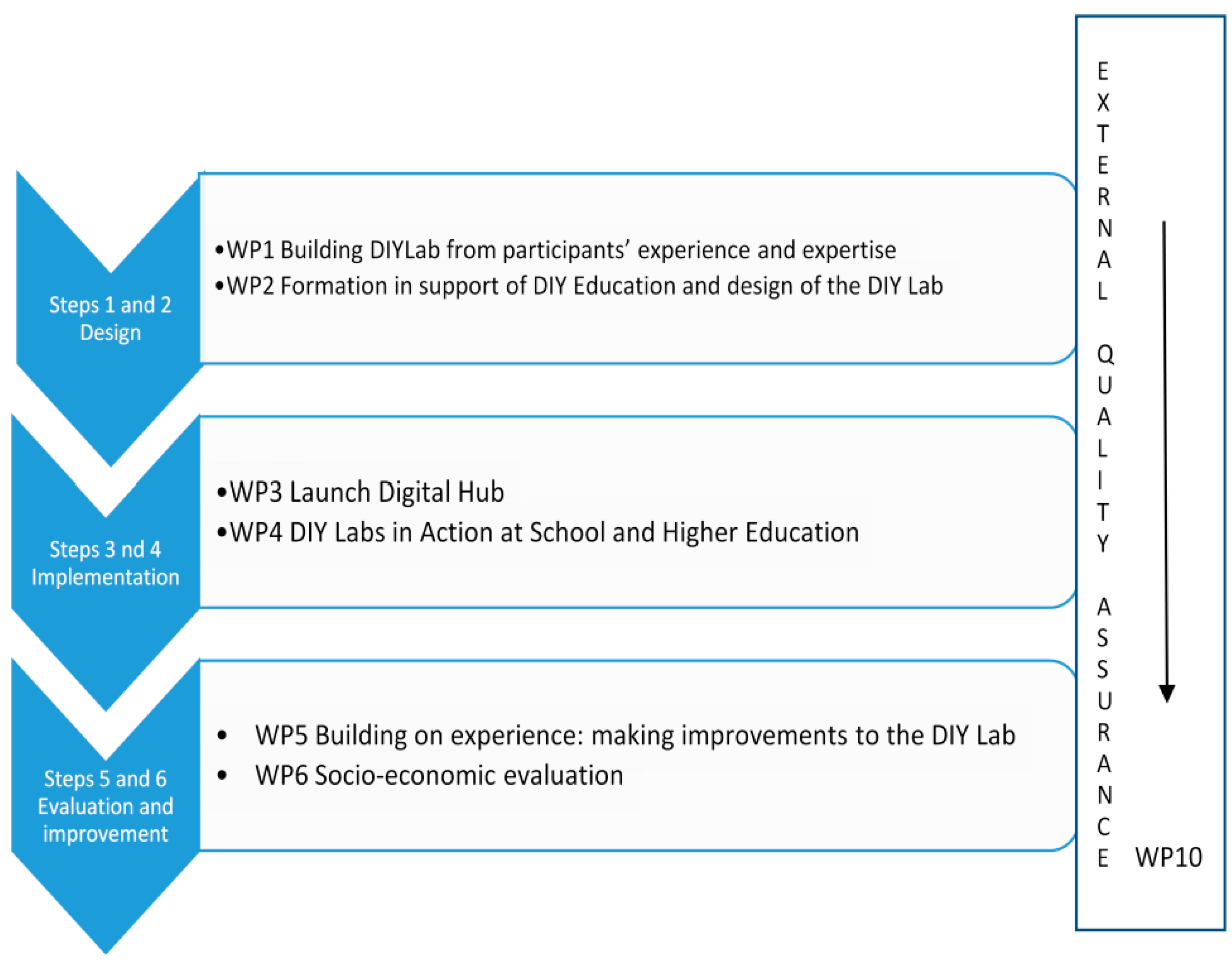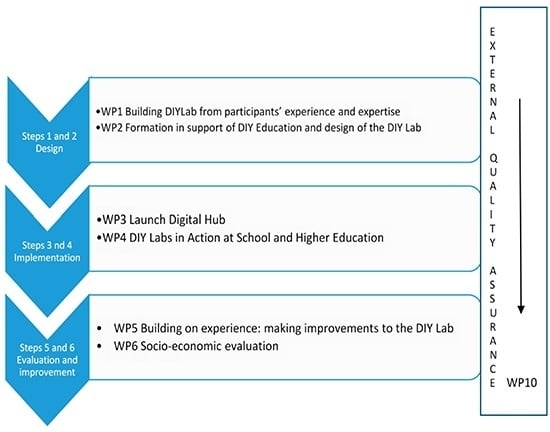This paper builds on the results of the 3-year long European project
Do It Yourself in Education: Expanding Digital Competence to Foster Student Agency and Collaborative Learning (DIYLab). Responding to the European Commission’s call for Lifelong Learning Programme Key Activity 3: 3.1.1. Reinforcing key competences, and taking into account the importance of research-practice partnership in education [
1], the project brought together three universities, three primary and three secondary schools with the common aim of combining educational innovation with today’s cultural and technical realities. The partners were the University of Barcelona (UB), Spain; the University of Oulu. Extension School and Teacher Training School (UOULU), Finland; Charles University in Prague (CUNI), Czech Republic; Escola Virorai, Spain; and ZŠ Korunovační (KORUNKA) School, Czech Republic.
1.1. Project Background
At present, there is a growing need to understand and foster knowledge and skills required for education and training better suited to meet society’s challenges, to better equip citizens with key competences and to develop 21st century lifelong and life-wide learning skills [
2]. For the Organisation for Economic Co-operation and Development (OECD’s) DeCeSo project [
3], it is clear that competence implies several dimensions starting from the ability to (a) use a wide variety of tools; (b) interact with others in heterogeneous groups; and (c) take responsibility for one’s life and act autonomously. At the heart of the key competences, the document suggests, lies
reflectiveness. Consistent with the initial diagnosis of a globalised world, the ability to handle differences and deal with contradictions so defining for non-standard, complex situations is clearly evident. “Today’s diverse and complex world demands that we do not necessarily rush to a single answer, to an either-or solution, but rather handle tensions [...] by integrating seemingly contradictory or incompatible goals as aspects of the same reality” [
3] (p. 9). Although most policy documents then continue to list specific skill sets, reflectiveness often remains ill-defined.
In any case, many of the abilities related to competences are transversal—cutting across different subjects and educational system levels—and digital technologies can help to support them. However, although competences may be quite concisely defined, they are less evident in practical terms and “difficult to be transferred to the context of schools” [
4] (p. 58) and [
5]. Fostering such competences requires novel strategies and teaching approaches based on active modes of learning, such as collaborative learning, peer-learning communities, creative problem solving, learning by doing, experiential learning, and the development of critical thinking and creativity.
Digital competence is considered as a core skill for life and employability. Today, the question is not whether digital technology (DT) should be used, but rather what is its impact on the way people learn and approach and value knowledge; and why, how, where and for what educational goals should it be used. Accordingly, our attention turns to pedagogical support, learning opportunities and assessment approaches that will encourage the acquisition of digital and other key competences, because “competences are associated with successful behaviour in non-standardized situations” [
6] (p. 86), and are “more than just knowledge and skills. They involve the ability to meet complex demands, by drawing on and mobilising psychosocial resources (including skills and attitudes) in a particular context” [
3] (p. 3) and [
7]. In this light, the DIYLab project assumes that in order to address digital competence in its complexity, we should consider current teaching practices and institutional cultures [
8,
9]. This is why the project closely worked with schools and universities in a Collaborative Action Research process [
10] to foster a lasting commitment to innovation.
In 2006, the European Commission (EC) defined eight key competences—understood as a combination of knowledge, skills and attitudes—necessary for personal fulfilment, active citizenship, social cohesion and employability in a knowledge society. One of them is digital competence. The EC recommendation suggests that: “Digital competence involves the confident and critical use of Information Society Technology (IST) for work, leisure and communication. It is underpinned by basic skills in ICT: the use of computers to retrieve, assess, store, produce, present and exchange information, and to communicate and participate in collaborative networks via the Internet.” [
11] (p. 15). Similarly, in different European countries, the government has established basic competences for all infant, primary and secondary school curricula. Universities have also adopted this logic [
12].
As suggested earlier, for different authors [
13,
14] digital competence may be quite concisely defined, although this definition is less evident in practical terms and difficult to be transferred to the institutional contexts. In fact, Ferrari, Punie & Redecker [
15] have identified up to fifteen frameworks to approach digital competence, while Hatlevik & Christophersen [
16] consider different concepts around the use of digital tools, such as digital competence, digital literacy, media literacy, digital skill, Internet skills and others. Likewise, Mills [
17] (p. 246) refers to the “increased attention to new literacy practices in digital environments across a variety of social contexts” as the digital turn.
While for policy-makers, digital competence consists of having the ability to search, obtain, handle and communicate information, and to transform it into knowledge. It incorporates different skills, ranging from access to information to its transmission through various media once it has been processed, including the use of ICT as essential for informing oneself, learning and communicating. It is associated with the search, selection, recording and processing or analysis of information, using a variety of techniques and strategies to access it according to the source and support used (oral, print, visual, digital or multimedia). It requires a basic command of specific languages (textual, numerical, iconic, visual, graphic and audio) and guidelines for decoding, transferring and applying knowledge in different situations and contexts. Digital competence involves making regular use of the technological resources available to solve real problems efficiently. At the same time, it enables the evaluation and selection of new information sources and technological innovations as they appear, in terms of their usefulness for undertaking specific tasks or objectives [
4].
It also means placing special emphasis on the idea that being digitally competent means being autonomous, efficient, responsible, critical and reflective in selecting, processing and using information and its sources, as well as using different technological tools. It also implies having a critical attitude and a reflective assessment of the information available, contrasting if necessary, and respecting the socially agreed rules of conduct to regulate the use of the information and its sources in the different media [
4].
Due to the difficulty of implementing competence-based curricula in an educational tradition grounded in subject-based curricula [
9,
18]), there is a pressing need to better understand and support the learning of digital competence equally in formal, informal and non-formal learning. Linking the three kinds of learning experiences is paramount to contributing to the development of lifelong and life-wide learning. Here, we must take into account that initial and in-service teacher professional development is not paying enough attention to new knowledge and skills, especially those related to digital competence.
Today, DT is present in schools and universities. eBooks, interactive blackboards, tablets or notebooks are now commonplace in Europe’s classrooms. However, when using this technology, students are typically positioned as consumers [
19]. This is why our project aims to reposition them as prosumers, as people who not only consume but produce media, and do it from a critical perspective [
20]. The pedagogical approach underpinning the project builds on the experience gained by partners in European, national and international projects. It also draws on lessons offered by DIY culture, and requires students to become producers of educational digital objects, rather than only consumers of what teachers or educational software companies offer [
21].
The Emergence of DIY Culture
In the last decade, young people’s relationship with DT has evolved. Our understanding of digital competences has shifted from considering
youth’s critical understanding of new media as one key aspect of digital literacy [
22,
23] to seeing young people not only as consumers but as content producers contributing to blogs, designing animations, graphics, and video productions [
24]. This has generated alternative approaches to digital competence to develop “creative designs, ethical considerations, and technical skills to capture youths’ expressive and intellectual engagement with new media.” [
25] (p. 89).
From this perspective, the DIYLab project took into account the change (and its educational effects) occurring in the last decade regarding digital competencies, especially the emergence of a culture of collaboration connected to youth learning environments, technology and DIY philosophy [
20,
21,
22,
23,
24,
25]. Young people’s efforts to create and disseminate digital media have been associated with the growing do-it-yourself (DIY) movement [
26]. Starting in the 90‘s [
27] with arts, crafts, and new technologies [
28,
29], it is now prevalent in curriculum contents [
30,
31] giving educators and students the opportunity to create, share and learn in collaboration. In recent years, the DIY philosophy has found a formidable push in the
Maker movement, deeply based on DT, more focused on software and supported in open-source hardware. It relishes the creation of new devices as well as mending and playing with existing ones [
32]. Heavily founded projects such as the Fab Lab (
http://fab.cba.mit.edu/) initiative, launched by the Media Lab in the Massachusetts Institute of Technology [
33] or The Digital Media and Learning Research Hub (
http://dmlhub.net/), of the University of California, Humanities Research Institute, have considerably approached educational institutions with these open learning cultures. We have also considered the countless DIY and Maker communities, taking into account that our aim was to develop DIY cultures in formal institutions—in other words, in highly prescriptive and inertial contexts, and that we wanted to do it across the curriculum, not necessarily to produce objects, but to foster autonomous and reflective learning in collaboration.







